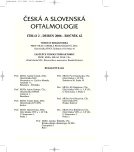Korelace vstupní rány a výsledného uložení kovového nitroočního tělesa pomocí počítačového modelování
Computer Modeling Correlation between the Entering Wound and the Final Position of the Metallic Intraocular Foreign Body
Aim:
The aim of this study was to establish the correlation coefficient between given parameters of the entering wound and final position of the metallic intraocular foreign body. Material and methods: fifty patients (50 eyes) with a penetrating injury of the eye and present metallic intraocular foreign body were included in this study. Clinically found data of the entering wound and final position of the intraocular foreign body (IFB) as well were transformed with a computer model into the three-dimensional parameters. Both chirurparameters were statistically evaluated by means of correlation analysis, and correlation coefficient and determination coefficient were calculated.
Results:
The extent of correlation between two variables is called correlation coefficient. The coefficient values range between -1 to +1. The closer is the calculated value to ranges (to -1 or to +1) the more are the two variables more correlated. The coefficient of determination values range from 0 to +1. The closer the results are to +1, the better the model describes the dependence between the two variables. The results obtained by means of correlation analysis were for the correlation coefficient 0.454, and for the coefficient of determination 0.6411 respectively.
Results:
Results of the correlation analysis show that the knowledge of coordinates of the entering wound has no prediction value for final position of the foreign body in the eye. These two variables are not correlated and so the accurate final position of the foreign body cannot be predicted. The final position of the intraocular metallic foreign body is probably influenced by biophysical factors not included in this study.
Key words:
penetrating injury of the eye, metallic intraocular foreign body, correlation analysis, computer modeling
Autoři:
H. Došková 1; P. Kršek 2
Působiště autorů:
Oftalmologická klinika LF MU a FN, Brno Bohunice
přednosta prof. MUDr. Eva Vlková, CSc.
1; Ústav počítačové grafiky a multimedií FIT VUT, Brno
vedoucí ústavu doc. Dr. Ing. Pavel Zemčík
2
Vyšlo v časopise:
Čes. a slov. Oftal., 62, 2006, No. 2, p. 110-118
Souhrn
Cíl:
cílem práce bylo podle stanovených parametrů vstupní rány a výsledného uložení kovového nitroočního tělesa stanovit korelační závislost obou veličin.
Materiál a metodika:
do retrospektivní studie bylo zařazeno 50 pacientů (50 očí) s otevřeným poraněním oka a přítomným kovovým nitroočním tělesem. Klinicky zjištěná data vstupní rány a výsledného uložení cizího nitroočního tělesa (CNT) byla převedena do trojrozměrně definovaných parametrů pomocí počítačového modelu. Oba parametry byly statisticky zpracovány metodou korelační analýzy se stanovením korelačního koeficientu a koeficientu determinace.
Výsledky:
mírou korelace mezi dvěma proměnnými je tzv. koeficient korelace. Koeficient nabývá hodnot od -1 do +1. Čím je jeho hodnota bližší plus nebo minus jedné, tím více jsou veličiny korelované. Koeficient determinace nabývá hodnot od 0 do +1. Čím více se výsledky blíží hodnotě +1, tím lépe model popisuje závislost mezi dvěma veličinami. Výsledky zpracované korelační analýzou prokázaly nejvyšší hodnoty korelačního koeficientu, resp. koeficientu determinace 0,454, resp. 0,6411.
Závěr:
z výsledků provedené korelační analýzy vyplývá, že pomocí znalosti souřadnic vstupu nedokážeme predikovat konečné souřadnice tělesa v oku. Tyto dvě proměnné jsou navzájem nekorelované a proto přesná predikce konečné polohy tělesa v oku není možná. Na výsledné umístění kovového CNT po vstupu do oka mají zřejmě vlivy biofyzikální faktory, které nebyly zahrnuty do studie.
Klíčová slova:
otevřená poranění oka, kovové nitrooční těleso, korelační analýza, počítačové modelování
Štítky
OftalmologieČlánek vyšel v časopise
Česká a slovenská oftalmologie

2006 Číslo 2
- Diagnostický algoritmus při podezření na syndrom periodické horečky
- Stillova choroba: vzácné a závažné systémové onemocnění
- Familiární středomořská horečka
- Citikolin jako užitečný pomocník v léčbě diabetické retinopatie a glaukomu
- Léčba zánětů spojivek a mazových žlázek víčka v primární péči
Nejčtenější v tomto čísle
- Vernální keratokonjunktivitida a možnosti její léčby Kazuistika
- Orbitální protéza po exenteraci očnice se zachováním víček a spojivkového vaku
- Vliv implantace IOL na zrakovou ostrost, kontrastní citlivost a barvocit za 2 a 4 měsíce po operaci katarakty
- Bilaterálna retinálna vaskulitída s arteriálnymi aneuryzmami
